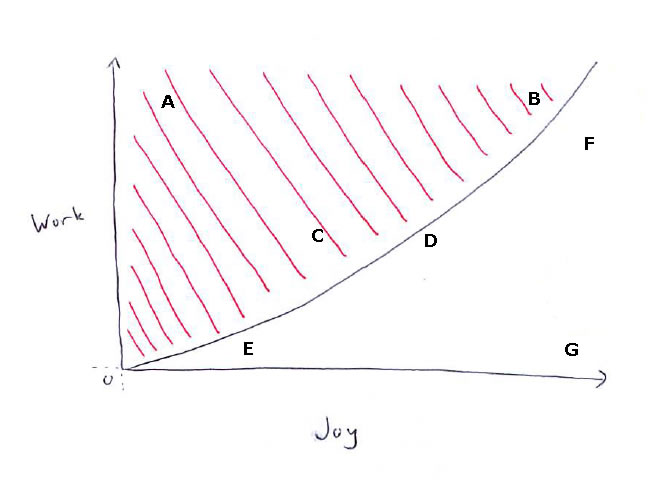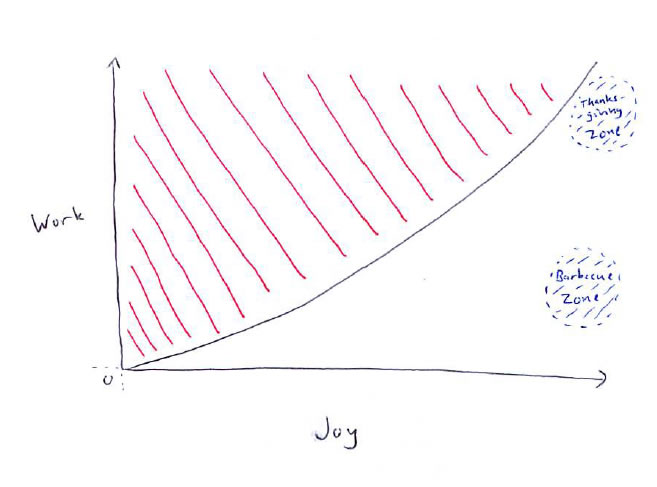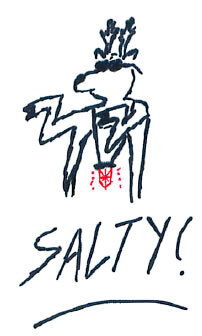K and I were talking about a cooking conundrum. We like cooking, and sometimes we produce something glorious, only it required six pans and three cutting boards and two hours. On the other hand, some food is not transcendent but does have the advantage of being easy to obtain. Grilled cheese, for example, has a pretty definite ceiling on how good it can really be, but you also know going in that you’ll spend more time eating it than cooking it. So it’s really not all about how good something is, it’s really all about the ratio between how good it is versus how much work is required. If two meals are equally tasty, the lesser work option would definitely be the way to go.
[Worth elucidating: deliciousness is variable. How much I want cake has a clear dependence on how recently I have eaten cake: if I’ve eaten it four days in a row, I wouldn’t go out of my way to get more. If I haven’t had it in three years (but could overcome my crippling depression about not having had cake for three years), I would probably be willing to burn an entire Saturday making it, if that’s what was required.]
Like all awesome things, this can be understood better with a graph. Here is such a graph, with a few example plotted points:
You’ll probably want to make anything that ends up in the white area because it has an acceptable Work::Joy, or Function-Over-Obtainable-Deliciousness, or FOOD, ratio. You can see that there is a forbidden zone of food where the work required outweighs the deliciousness obtained. This is the area shaded red.
To understand this graph in more detail, let’s first consider the axes.
Work (vertical) axis: The higher up you get vertically, the more work involved. So, something right at zero would be the easiest possible thing. I’ll define that as “opening a bag of something.” The food is already made and edible, you just have to negotiate the container. (I guess if you want to get technical, ZERO work would not even be as much effort as opening a bag. It would be someone bringing you the bag, opening it for you, then putting the food directly into your mouth. But let’s set our baseline just a little above that.) I suppose there is theoretically no upper limit, as you could always do more work on food. Instead of baking bread with flour from a bag, I could grind the wheat myself. I could further plant and harvest the wheat that I would grind. I could further enroll in a genetic engineering program and create a new strain of wheat to plant, harvest, and grind, etc. But probably a multi-course meal planned and prepared in stages over the course of hours or days is more realistic.
Joy (horizontal) axis: Also knows as The Axis of Deliciousness. Joy increases as you move rightwards. Certainly there are foods that create negative Joy (e.g., mayonnaise) but there’s no reason to consider them here. Something with minimal joy is something eaten merely as sustenance. The classic example is a rice cake–which does have the benefit of zero work, at least. The origin could therefore be called the Rice Cake Point.
Now let’s examine each labeled point.
A. This point represents food you would never bother with. It’s a clear-cut forbidden zone case, requiring a lot of work with little joy, and the worst-possible FOOD. For me, this is probably something like salmon.
B. Same amount of work as A but much more delicious. Very highly delicious, in fact, but still so much work that it’s probably not worth all the trouble. But it’s close to the line, so a debate. Maybe some sort of lasagna.
C. Close to the line, so something you’d have to think about like B, but still falling into the forbidden zone. Despite being a lot less work than B, there’s still low joy, and hence, an unacceptable FOOD. Moderately difficult and moderately tasty, but just not quite worth it. Notice that if it was either just a little less work or a little tastier it would be worthwhile. I think most homemade soups end up in this area for me. I mean, they’re pretty good, but nothing terribly exciting, and usually there’s just a bit too much prep for what I know is coming: you know, soup.
D. Similar to C in that this is something moderately tasty and moderately easy. But, better FOOD than C, and hence, over the line and worth making. Lots of things in this area. Pancakes? Understanding that pancakes are highly variable, of course.
E. Something quite easy, but with minimal joy. Acceptable FOOD but probably only because it is easy. Probably the realm of cereal.
F. Despite the maximization of deliciousness here, this will also take a lot of effort. Food that reside in this area of the graph are special occasions. Hence, I will designate this area the Thanksgiving Zone.
G. The most glorious area of the graph. Maximized deliciousness with minimal work. Best possible FOOD. I deem this the Barbecue Zone.
Please use this graph to help understand your life (as it relates to food) better.
Your thoughts?


